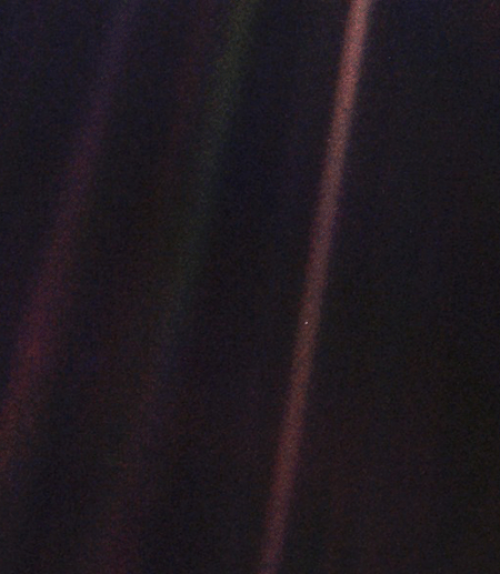In the pantheon of famous self-portraits, this one is less than a pixel – and it is us.
The iconic photograph of planet Earth from distant space – the “pale blue dot” – was taken 30 years ago – Feb. 14, 1990, at a distance of 3.7 billion miles, by the NASA spacecraft Voyager 1 as it zipped toward the far edge of the solar system. The late Cornell astronomy professor Carl Sagan came up with the idea for the snapshot, and coined the phrase.
“The Pale Blue Dot image shows our world as both breathtakingly beautiful and fragile, urging us to take care of our home,” said Lisa Kaltenegger, associate professor of astronomy and director of Cornell’s Carl Sagan Institute.
“We are living in an amazing time,” she said, “where for the first time ever we have the technical means to spot worlds orbiting other stars. Could one of them be another pale blue dot, harboring life? That is what we are trying to find out at the Carl Sagan Institute.”
NASA’s Voyager 1 launched on Sept. 5, 1977, to explore the solar system and beyond. The spacecraft flew past Jupiter on March 5, 1979, and by Saturn on Nov. 12, 1980. A decade later, it was time for a solar system family portrait.
Sagan, part of Voyager’s imaging team, is credited with the idea of having Voyager 1 take images of Earth and its sibling planets. Sagan knew the picture would render Earth as just a dot of light, but as stated on the NASA website, the Voyager team “wanted humanity to see Earth’s vulnerability and that our home world is just a tiny, fragile speck in the cosmic ocean.”
On Feb. 13, 1990, NASA and Jet Propulsion Laboratory engineers sent commands to Voyager 1 to face Earth in order to get the photo. A day later, three Earth-as-a-dot images were taken – then NASA shut down Voyager 1’s camera permanently, to conserve energy for the rest of its decadeslong mission.
Downloading the images took several weeks: The final download occurred May 1, 1990, via NASA’s Deep Space Network.
As of Feb. 14, the elapsed mission time for the Voyager 1 spacecraft is 42 years, five months and 10 days. The craft is about 13.8 billion miles from Earth and traveling at 38,000 miles per hour. NASA and the JPL still keeps tabs on it; the next check will be Feb. 16.
Look again at that dot. That’s here. That’s home. That’s us. On it, everyone you love, everyone you know, everyone you ever heard of, every human being who ever was, lived out their lives. —Carl Sagan and Ann Druyan
In addition to conceptualizing the famed photo, Sagan was one of the creators of the Golden Record – a 12-inch, gold-covered copper disc, carrying an interstellar message – aboard Voyager 1 and the spacecraft’s sibling, Voyager 2. Ann Druyan, Sagan’s widow and a Peabody and Emmy award-winning writer and producer, served as creative director of Voyager’s Interstellar Message.
In their 1994 book, “Pale Blue Dot: A Vision of the Human Future in Space,” Druyan and Sagan took a poetic and holistic view of Earth – as a tiny speck, a pixel – in the famed photo.
“Look again at that dot,” they wrote. “That’s here. That’s home. That’s us. On it, everyone you love, everyone you know, everyone you ever heard of, every human being who ever was, lived out their lives. The aggregate of our joy and suffering, thousands of confident religions, ideologies and economic doctrines, every hunter and forager, every hero and coward, every creator and destroyer of civilization, every king and peasant, every young couple in love, every mother and father, hopeful child, inventor and explorer, every teacher of morals, every corrupt politician, every ‘superstar,’ every ‘supreme leader,’ every saint and sinner in the history of our species lived there – on a mote of dust, suspended in a sunbeam.”
Read this article in the Cornell Chronicle.




